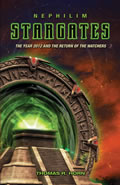PART 4
By Thomas R. Horn
October 26, 2013
NewsWithViews.com
Your
wallet and credit cards are obsolete. You may as well leave them at
home on a shelf near your dusty antique collection, reminding you
of ancient history. While shopping for your shampoo and toothpaste,
you need naught but to 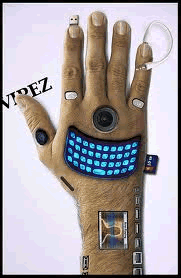 wave
your right hand over a scanner at the checkout counter to pay for
and collect your goods, as the amount due will be automatically withdrawn
from your bank account.
wave
your right hand over a scanner at the checkout counter to pay for
and collect your goods, as the amount due will be automatically withdrawn
from your bank account.
But, of course, this is either too fantastical to be true, or too far off in the future for you to worry about. Right?
Survey says: Incorrect.
The technology at our hands (literally) before 2017 will cover, and exceed, such a feat. Take, for example, a standard laser scanner (be it handheld or fixed) at any store checkout. The reading of barcodes and Universal Product Codes (UPCs) by machine to report your purchases to a computer is already outdated news. The only old-fashioned cash registers in use in modern times are made of rainbow-colored plastic and produced by Fisher Price. How endearing.
“But just suggest something like an implant in human beings and the social outcry is tremendous,” said Tim Willard ten years ago, then executive officer of the World Future Society, a Washington, DC-based organization that claimed twenty-five thousand members worldwide, including Future Shock author Alvin Toffler. “While people over the years have grown accustomed to artificial body parts, there is definitely a strong aversion to things being implanted. It’s the ‘BIG BROTHER is watching’ syndrome. People would be afraid that all of their thoughts and movements were being monitored. It wouldn’t matter if the technology were there or not. People would still worry.”
But wait, we’re getting a bit ahead of ourselves here. First we need to define the term “future shock” and how it came into our vocabulary. According to Merriam Webster’s Collegiate Dictionary, Eleventh Edition, “future shock” is defined as: “The physical and psychological distress suffered by one who is unable to cope with the rapidity of social and technological changes.” As words in the dictionary go, this one is of fairly recent origin. The dictionary tells us that it first came into common usage about 1965.
Toffler cannot directly be credited with originating the term, but using it as the title of his book certainly promulgated its wide acceptance, and the definition is one with which most people of this decade are familiar, to at least some degree.
Future shock has come to be considered a negative term that bridges the age gap from children (who feel they are being propelled into the future before they are ready, and that adults have pretty much messed it up for them anyway) to senior citizens (who are befuddled by all this electronic computer technology and long for the “good old days”). It also bridges all areas of life, from banking, economics, and industry to education, social sciences, art, music, communications, databases, etc. We are being hurled ever forward by knowledge that is expanding exponentially.
And the most distressing symptom of future shock is the dehumanizing feeling we experience that we are all becoming nothing more than numbers…and in fact, that is the truth. With the world shrinking because of travel and communication technology and the pressure by the “powers that be” to merge us all into a one-world government (spell that, New World Order), the only way to “organize” us and keep track of us (for our own good, of course), is to give us all a single identification method that can be recognized worldwide.
So, future shock is real…it’s just not very much in the future anymore. Future shock is here…future shock is now. Perhaps “Big Brother” wasn’t watching us by the year 1984, as Orwell’s book title speculates, but he wasn’t all that far off target. The technology is here now via fiber optics, wireless transmissions, satellites, and other modern marvels for Big Brother to sit on the information superhighway, right in your living room. The only difference is that during the time from 1984 to now, we have been brainwashed into believing that this is a wonderful thing, so Big Brother didn’t have to force his way in, as Orwell postulated; he is with us by our own invitation.
Biochip—RFID Technology
The
very idea of implanting even our pets with identifying microchip transponders
was a concept that for years was approached very slowly. “We
wanted to make sure it’s right for the animals, and that the
community is 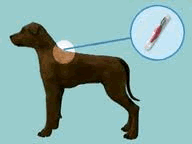 willing
to accept this new technology,” said Diane Allevato, director
of the Novato, California, animal shelter. Now, however, such high-tech
“tagging” is on “fast forward” since people
have grown accustomed—by successful conditioning—to what
once was considered offensive technology. For example, if people are
now willing to have such devices injected into their pets, why would
they not put them into their own bodies? Or, to soften the blow just
a little, into the elderly or children to prevent wandering from home
or kidnapping, prison inmates, and runaway teens, because all that
would be for the good of society as a whole. Once you have edged your
way into accepting these logical implant choices, it’s no great
leap to accept the fact that a nonremovable implant or high-tech tattoo
would be terribly convenient and much safer for us than carrying around
cards for all our needs (economic, health, passports, travel, etc.)—cards
that could be lost or stolen.
willing
to accept this new technology,” said Diane Allevato, director
of the Novato, California, animal shelter. Now, however, such high-tech
“tagging” is on “fast forward” since people
have grown accustomed—by successful conditioning—to what
once was considered offensive technology. For example, if people are
now willing to have such devices injected into their pets, why would
they not put them into their own bodies? Or, to soften the blow just
a little, into the elderly or children to prevent wandering from home
or kidnapping, prison inmates, and runaway teens, because all that
would be for the good of society as a whole. Once you have edged your
way into accepting these logical implant choices, it’s no great
leap to accept the fact that a nonremovable implant or high-tech tattoo
would be terribly convenient and much safer for us than carrying around
cards for all our needs (economic, health, passports, travel, etc.)—cards
that could be lost or stolen.
Biochip the Size of a Grain of Rice
For pets, the implanted chip is the size of a single grain of rice. It stores a number that identifies the pet’s individual information (including the name of the pet, as well as the name, address, and phone number of the pet owner), which can be accessed by computer via a scan over the outside of the skin.
The Novato, California, animal shelter mentioned earlier was the first shelter in the country to use the biochips. One lady phoned the shelter to say she felt the implants were “unnatural and weird.”
“And there is no doubt about it, injecting an animal with such a chip is a pretty unnatural thing to do,” Allevato said. “But it’s also unnatural, obscene really, that about 15 million stray animals are destroyed in this country each year because their owners cannot be found.”
As of the writing of this manuscript, animal implants are no longer considered “unnatural and weird.” In fact, the system is in common usage worldwide, and the “service” is readily available to pet owners at many veterinarians and animal hospitals. In addition, animal chipping has evolved from being a mere suggestion to becoming a mandate in most urban areas when pets are adopted from a shelter or bought from a store.
The transponder chips being implanted into most animals today are manufactured by four major companies: American Veterinary ID (AVID) of Norco, California; Infopet Corporation of Minnesota; Hughes Aircraft in Southern California; and Texas Instruments of Attleboro, Massachusetts. Originally, Destron IDI Corporation of Boulder, Colorado, began the concept, but it now serves primarily as a research and development company for both Hughes and Texas Instruments, through various joint ventures.
RFID Implants: Are We Ready?
Many
more companies have now entered the RFID manufacturing field, and
biochip usage now has surpassed the “personal pet” stage
and is being used in many different areas of farming, ranching (no
need for old-fashioned branding irons), racing, and wildlife identification
and monitoring. In conjunction with 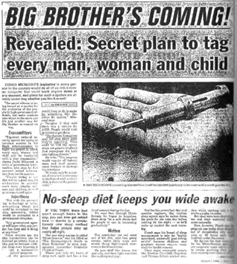 computer
technology, RFID biochips are used to track and monitor the health
histories, bloodlines, etc., of various farm animals, race horses,
breeding stock, prize-breeding stock, and more.
computer
technology, RFID biochips are used to track and monitor the health
histories, bloodlines, etc., of various farm animals, race horses,
breeding stock, prize-breeding stock, and more.
In the modern dairy business, good ol’ Bessie can come into the barn, pass under a scanner, be directed to her stall, and find her own specially prepared diet in place, just awaiting her arrival—all based upon her identification combined with the computer-stored information about what the handlers want her to eat. Her health records, milk production, and other pertinent factors are all considered, and the optimum diet is assigned to her.
Wildlife has been tagged and tracked manually/visually for many years, but now it is possible to track life as small as a honeybee by attaching an RFID to its back. Of course, this is a real stroke of genius, according to the ecologists, for monitoring all types of wildlife, especially the endangered species.
According to Destron director Jim Seiler, implantable RFID biochips are even being used to track fish. In some fishery applications, salmon are injected with these biochips, then scanned and tracked as they pass through specially equipped dam sites “to assure environmentalists that they are not being chewed up in the dam’s power turbines,” Seiler said.
Following that, reports were coming out of Europe that poachers were being caught and fined because the biochip implants in the fish led the authorities to the poacher. The implications of this announcement were staggering. It meant that the biochip no longer had to be scanned at a close distance of three to twelve inches. It would indicate that technology has been developed and actually put into service that could scan for detection of biochips at great distances, possibly even by satellite. This was, in fact, the ultimate direction biochip technology was heading at the time, as surveillance and control of humans is of far more importance to the leaders of the New World Order than the tracking of animals. Biochips being manufactured now can send and receive data about location and personal information from anywhere in the world, and this technology not only exists in biochips, but a similar technology exists within the digital devices in every purse and back pocket in the country.
Take, for example, your smart phone or laptop (or any other portable convenience like electronic pads, notebooks, etc.). If your phone was purchased within the last couple of years from any major carrier, it likely came with a preinstalled GPS that keeps constant tabs on your travels. And, of course, that’s handy when you need it for navigational purposes. What you may or may not know about this feature is that unless you go out of your way to turn the GPS in your phone off (it stays on perpetually otherwise), it attaches personal information to all other data-share occurrences on your phone.
Remember that picture you took of Aunt Suzie at the barbecue last weekend? Remember when you uploaded that picture to Facebook and tagged all your friends in it? You left your GPS on in your phone at the moment the picture was taken, and now you, Aunt Suzie, and all others tagged in the photograph are shown as “present” at that barbecue event last weekend. The address and map directions to that exact location are provided at no extra cost by the click of a mouse (again, available to anyone with Internet access, not just “Big Brother”). Not only did you unknowingly report the address where you were last weekend, but you reported the location of Aunt Suzie and your friends.
GPS TRACKER IN CELL PHONES
If
you chose to leave your personal home address where your spouse and
children live omitted from the personal information tab on your Facebook
account to ensure privacy, you just negated that safety step by taking
a ![]() picture
of Billy in his highchair and posting it online, forgetting of course
to disconnect your phone’s camera from the ever-present GPS.
Now Billy can be tracked to his highchair, map and directions to your
home included, by anyone online—and it does not stop simply
with your phone’s camera. Whereas nobody may be referring to
this cellular phone feature as a biochip implant, it’s essentially
a chip you voluntarily carry with you everywhere, reporting everything
that you do and everywhere you’ve been. If or when a mandatory,
government-issued or world-government-issued implantable chip does
become the new deal, the leap from your smart phone to the new chip
in your hand will not be a hard one at all.
picture
of Billy in his highchair and posting it online, forgetting of course
to disconnect your phone’s camera from the ever-present GPS.
Now Billy can be tracked to his highchair, map and directions to your
home included, by anyone online—and it does not stop simply
with your phone’s camera. Whereas nobody may be referring to
this cellular phone feature as a biochip implant, it’s essentially
a chip you voluntarily carry with you everywhere, reporting everything
that you do and everywhere you’ve been. If or when a mandatory,
government-issued or world-government-issued implantable chip does
become the new deal, the leap from your smart phone to the new chip
in your hand will not be a hard one at all.
While there are at least “10,000 application ideas to explore when it comes to the chip’s potential,” Seiler originally insisted, “Destron is only concerned with animal identification” and “is not considering HUMAN application” (emphasis added).
“There is no need to apply the technology to humans because the human fingerprint is unique enough to identify them,” Seiler said. “Animals don’t have such a unique identifier.” All present manufacturers deny that they are considering any form of human application; however, the latest info indicates to the contrary.
But Tim Willard, managing editor of the World Future Society’s bimonthly magazine, Futurists, said the technology behind such a human microchip is “fairly uncomplicated and with a little refinement, could be used in a variety of human applications.… Conceivably, a number could be assigned at birth and go with a person throughout life” (emphasis added), Willard said.
“Most likely,” he added, “it would be implanted in the back of the right or left hand for convenience, so that it would be easy to scan at stores.… It could be used as a universal identification card that would replace credit cards, passports, that sort of thing.… At the supermarket checkout stand, you would simply pass your hand over the scanner and your bank account would be automatically debited.… It could be programmed to replace a medical alert bracelet. For example, at the scene of an accident, a medic could scan the victim’s hand to find out his recent medical history, allergies, a relative to contact, etc. This would be especially valuable if the person were unconscious” (emphasis added).
In another very logical application, such microchips could replace the need for keys to home, car, and workplace locks, since the chip in one’s hand would serve as a universal key for all such locks. One would simply scan the back of his or her right hand over a high-tech microreader device designed into future locks to gain access. Security would be enhanced tremendously, since, allegedly, no one would be able to “pick” the locks, make a wax copy, or obtain a spare key found under a doormat. Doesn’t that make you feel really safe? Not if you understand that any burglar worth his salt has always found a way around locks and security devices, no matter how complex. It might serve as a deterrent to an inept thief, but a serious crook would manage to get in somehow. The bigger the target, the cagier the crooks. Just think of any major malicious virus caused by such minds in the past ten years online…most designed by brilliant computer-degree-bearing hackers no more intimidated by a futuristic door lock than someone’s email account.
New Biochips of Living Proteins and Hybrid Brain-Machine Interfacing
Some of the simple biochips of yesterday are now new biochips partially made of or with living proteins. According to Willard, “A powerful biochip…once surgically implanted in the brain, could make it possible to program or upload an unlimited amount of information into the mind, without ever having cracked a book…it will be infinitely smaller and have the capacity to carry much more information. It will have a wide range of functions that will simply boggle our minds.”
After hearing more and more news of hybrid brain-machine interfaces (HMBIs), mind-machine interfaces (MMIs), and brain-computer interfaces (BCIs), Willard’s comment seems almost tame. As far back as the 1970s, there has been a significant amount of focus put upon neuroprosthetics (artificial sensory intervention via prosthetics placed directly in the brain, essentially rerouting and/or repairing the brain’s communication with a body part due to birth defects, injury, or disease). After our country has observed the repeated miracles of such evolution between man and machine (literally observing the lame man walk, the blind man see, and the deaf man hear, among hundreds of other marvels of science), the fusion of a biochip with living proteins taking its podium in current labs is not hard to believe.
Loss of Freedom and Privacy
Chapter two of the upcoming book Beast Tech will discuss extensively the loss of our privacy and electronic bondage, but we should at least address it briefly here, as it contributes greatly to the future shock condition.
The
capabilities described above carry with them the inherent risk of
abuse by government and other organizations, particularly over the
issue of privacy. How will access to such information be limited and
controlled? And if (read 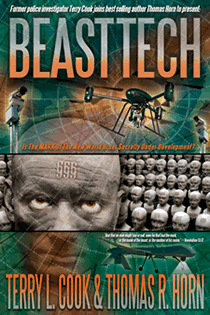 that
“when”) it is passed around (often without our knowledge,
much less our consent) to a variety of entities, both private and
governmental, how will we know of errors that occur when someone is
updating information? No system is foolproof…errors will always
occur somehow. The one at fault for the error will not make any adjustments
to their records/databases. You must determine the origin of the error
and try your best to get them to correct the mistake (not likely to
occur, we might warn you, since admitting such a blunder would make
them financially liable for any injury you might have suffered because
of their negligence). And getting them to pass such a correction on
to everyone who received the erroneous data from them is practically
hopeless.
that
“when”) it is passed around (often without our knowledge,
much less our consent) to a variety of entities, both private and
governmental, how will we know of errors that occur when someone is
updating information? No system is foolproof…errors will always
occur somehow. The one at fault for the error will not make any adjustments
to their records/databases. You must determine the origin of the error
and try your best to get them to correct the mistake (not likely to
occur, we might warn you, since admitting such a blunder would make
them financially liable for any injury you might have suffered because
of their negligence). And getting them to pass such a correction on
to everyone who received the erroneous data from them is practically
hopeless.
It would be very difficult to impose enforceable limitations on the availability of such information in today’s sophisticated environment of internationally linked databases. There would be no guarantees that confidential information might not inadvertently “leak” out to someone not authorized to have it…except YOU, of course. You are not authorized.
A Human Biochip ID System
A human microchip identification system, Willard said, “would work best with a highly centralized computer system where [only!] one identification number would gain access to medical, credit, academic, home security,” and other kinds of data. But under this arrangement, as you can imagine, security risks are somewhat intense.
“People tend to be idealistic about their independence and privacy, but the reality is that most information pertaining to education, credit history, whatever, is readily available to just about anyone who asks. Anyone who has ever experienced a simple credit check knows this,” Willard said.
One futurist found the concept of microchip implantation in humans offensive. “It reminds me of tattooing concentration camp victims during World War II,” said Robert Mittman of the Institute for the Future, a nonprofit research and consulting firm in California. He said there were better methods of identifying people than “violating the integrity of their skin.” He continued, “Personally, I have problems with it.… People would end up sacrificing some civil rights.”
Another concerned individual is the associate director of the American Civil Liberties Union (ACLU) for Northern California, Martha Kegal. She expressed concern over how private records would be kept from “inquiring minds” if such a system existed.
The System Is Already in Place
But the question is not whether such a system exists, because we all know it does. It is already in place and obvious to all but the most naïve. Rather, the question troubling most intelligent minds would seem to be the system’s final destination, as it were. Whenever we get to wherever it ultimately is taking us…will it have proven to be good or evil? For an answer to this question, we must turn to our Creator’s operations manual, the Bible, for only God knows how all things will end.
Only the Bible Has the Answers
According to God’s Holy Word, the result of all our present circumstances is quite clear. Our generation may well be the one that has been appointed to be alive at the time of the conclusion of all ages, better known as the end of the world. For the first time in history, the technology is available to accomplish the things prophesied in the Bible. Precisely which technology will be used is immaterial—the fact is, never prior to this generation has any technology been available to permit the conduct of commerce in the manner described in Revelation 13:16–17.
Such an end-times scenario necessarily involves the implantable biochip technology (or something comparable) around which the investigative book Beast Tech has been written, for without it, the final worldwide system of satanic government, as outlined in the books of Daniel and Revelation, simply would not be feasible.
| Subscribe to the NewsWithViews Daily News Alerts! |
Current technological, social, and/or political circumstances soon will lead to a system of universal totalitarian enslavement by means of a global economic network of computerized bartering. This system will be led by a global dictator whom the Bible calls the Antichrist. This Antichrist, Satan’s personal representative on the scene—the final “Hitler”—will successfully orchestrate the affairs of the entire globe via a one-world government. This man will be the very epitome of evil. The Bible tells us about the number 666 (of which Hollywood has made such a big deal in horror films). Of course, as is typical with Hollywood, the number really is a “big deal,” even though they treat it as fiction or myth. Consider the following: “That no man might buy or sell, save he that had the mark, or the name of the beast, or the number of his name. Here is wisdom. Let him that hath understanding count the number of the beast: for it is the number of a man; and his number is Six hundred threescore and six” (Revelation 13:17–18).
The Bible is very clear on another thing, too—that even the very elect will be deceived if they are not alert and do not exercise discernment.
WATCH THE BEAST TECH TRAILER
Click here for part -----> 1, 2, 3, 4, 5, 6, 7,
© 2013 Thomas Horn - All Rights Reserved
Thomas Horn is the CEO of RaidersNewsUpdate.com and SurvivorMall.com.
Over the last decade, he has authored three books, wrote dozens of published editorials, and had several feature magazine articles. In addition to past articles at NewsWithViews.com , his works have been referred to by writers of the LA Times Syndicate, MSNBC, Christianity Today, Coast to Coast, World Net Daily, White House Correspondents and dozens of newsmagazines and press agencies around the globe. Tom's latest book is "The Ahriman Gate," which fictionalizes the use of biotechnology to resurrect Biblical Nephilim.
Thomas is also a well known radio personality who has guest-hosted and appeared on dozens of radio and television shows over the last 30 years, including "The 700 Club" and "Coast to Coast AM." When looking for a spokesperson to promote their film "Deceived" staring Louis Gossett Jr. and Judd Nelson, "Cloud 10 Pictures" selected Thomas as their spokesperson to explain the Christian viewpoint on UFO-related demonology.
Web Site: RaidersNewsUpdate.com
E-Mail: RaidersNewsUpdate@gmail.com






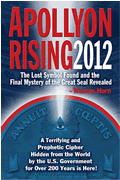



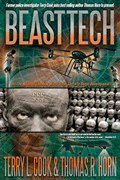





 Share
This Article
Share
This Article